Effect of Unit-Cell Size on the Barely Visible Impact Damage in Woven Composites
Abstract
:1. Introduction
2. Materials and Methods
2.1. Materials and Architectures’ Design
2.2. Composite Panels Manufacturing
3. Experiment and Characterisation
3.1. Optical Microscopy
3.2. Impact Testing
3.3. Nondestructive Testing of the Impact-Induced Damage
3.3.1. Ultrasonic C-Scanning
3.3.2. Digital Image Correlation (DIC)
3.3.3. X-ray Computed Tomography (CT)
4. Results and Discussion
4.1. Optical Microscopy
4.2. Impact Testing
4.2.1. Impact Force–Displacement Analysis
4.2.2. Damage Characterisation
4.2.3. X-ray CT Failure Analysis
5. Conclusions
Author Contributions
Funding
Conflicts of Interest
References
- Panettieri, E.; Fanteria, D.; Montemurro, M.; Froustey, C. Low-velocity impact tests on carbon/epoxy composite laminates: A benchmark study. Compos. Part B Eng. 2016, 107, 9–21. [Google Scholar] [CrossRef] [Green Version]
- Awais, H.; Nawab, Y.; Anjang, A.; Md Akil, H.; Zainol Abidin, M.S. Effect of fabric architecture on the shear and impact properties of natural fibre reinforced composites. Compos. Part B Eng. 2020, 195, 108069. [Google Scholar] [CrossRef]
- Wu, Z.; Zhang, L.; Ying, Z.; Ke, J.; Hu, X. Low-velocity impact performance of hybrid 3D carbon/glass woven orthogonal composite: Experiment and simulation. Compos. Part B Eng. 2020, 196, 108098. [Google Scholar] [CrossRef]
- Xin, W.; Sarasini, F.; Tirillò, J.; Bavasso, I.; Sbardella, F.; Lampani, L.; De Rosa, I.M. Impact and post-impact properties of multiscale carbon fiber composites interleaved with carbon nanotube sheets. Compos. Part B Eng. 2020, 183. [Google Scholar] [CrossRef]
- Bilisik, K.; Sapanci, E. Experimental determination of fracture toughness properties of nanostitched and nanoprepreg carbon/epoxy composites. Eng. Fract. Mech. 2018, 189, 293–306. [Google Scholar] [CrossRef]
- Shyr, T.-W.; Pan, Y.-H. Impact resistance and damage characteristics of composite laminates. Compos. Struct. 2003, 62, 193–203. [Google Scholar] [CrossRef]
- Francesconi, L.; Aymerich, F. Impact damage resistance of thin stitched carbon/epoxy laminates. Proc. J. Phys. Conf. Ser. 2015, 628, 12099. [Google Scholar] [CrossRef] [Green Version]
- Hosur, M.V.; Adya, M.; Alexander, J.; Jeelani, S.; Vaidya, U.; Mayer, A. Studies on impact damage resistance of affordable stitched woven carbon/epoxy composite laminates. J. Reinf. Plast. Compos. 2003, 22, 927–952. [Google Scholar] [CrossRef]
- Tan, K.T.; Watanabe, N.; Iwahori, Y. Effect of stitch density and stitch thread thickness on low-velocity impact damage of stitched composites. Compos. Part A Appl. Sci. Manuf. 2010, 41, 1857–1868. [Google Scholar] [CrossRef]
- Yoshimura, A.; Nakao, T.; Yashiro, S.; Takeda, N. Improvement on out-of-plane impact resistance of CFRP laminates due to through-the-thickness stitching. Compos. Part A Appl. Sci. Manuf. 2008, 39, 1370–1379. [Google Scholar] [CrossRef]
- Chen, F.; Hodgkinson, J.M. Impact behaviour of composites with different fibre architecture. Proc. Inst. Mech. Eng. Part G J. Aerosp. Eng. 2009, 223, 1009–1017. [Google Scholar] [CrossRef]
- Umer, R.; Alhussein, H.; Zhou, J.; Cantwell, W. The mechanical properties of 3D woven composites. J. Compos. Mater. 2016. [Google Scholar] [CrossRef] [Green Version]
- Seltzer, R.; González, C.; Muñoz, R.; Llorca, J.; Blanco-Varela, T. X-ray microtomography analysis of the damage micromechanisms in 3D woven composites under low-velocity impact. Compos. Part A Appl. Sci. Manuf. 2013, 45, 49–60. [Google Scholar] [CrossRef] [Green Version]
- Hart, K.R.; Chia, P.X.L.; Sheridan, L.E.; Wetzel, E.D.; Sottos, N.R.; White, S.R. Mechanisms and characterization of impact damage in 2D and 3D woven fiber-reinforced composites. Compos. Part A Appl. Sci. Manuf. 2017, 101, 432–443. [Google Scholar] [CrossRef]
- Kazemianfar, B.; Esmaeeli, M.; Nami, M.R. Experimental investigation on response and failure modes of 2D and 3D woven composites under low velocity impact. J. Mater. Sci. 2020, 55, 1069–1091. [Google Scholar] [CrossRef]
- Miao, H.; Wu, Z.; Ying, Z.; Hu, X. The numerical and experimental investigation on low-velocity impact response of composite panels: Effect of fabric architecture. Compos. Struct. 2019, 227, 111343. [Google Scholar] [CrossRef]
- Cao, W.; Zhang, J.; Sun, B.; Gu, B. X-ray tomography and numerical study on low-velocity impact damages of three-dimensional angle-interlock woven composites. Compos. Struct. 2019, 230, 111525. [Google Scholar] [CrossRef]
- Gil, L.; Oller, S.; Pérez Martínez, M.A. Non-destructive testing evaluation of low velocity impact damage in carbon fiber-reinforced laminated composites. Ultrasound 2011, 66, 21–27. [Google Scholar]
- Grondel, S.; Assaad, J.; Delebarre, C.; Moulin, E. Health monitoring of a composite wingbox structure. Ultrasonics 2004, 42, 819–824. [Google Scholar] [CrossRef]
- Savin, A.; Barsanescu, P.D.; Vizureanu, P.; Stanciu, M.D.; Curtu, I.; Iftimie, N.; Steigmann, R. Damage detection of carbon reinforced composites using nondestructive evaluation with ultrasound and electromagnetic methods. In IOP Conference Series: Materials Science and Engineering, Proceedings of the International Conference on Innovative Research—ICIR Euroinvent 2016, Iași, Romania, 19–20 May 2016; IOP: Bristol, UK, 2016; p. 12013. [Google Scholar]
- Saeedifar, M.; Saleh, M.N.; El-dessouky, H.M.; Freitas, D. Damage assessment of NCF, 2D and 3D woven composites under compression after multiple-impact using acoustic emission. Compos. Part A Appl. Sci. Manuf. 2020, 132. [Google Scholar] [CrossRef]
- Li, Z.; Haigh, A.D.; Nasr Saleh, M.; McCarthy, E.D.; Soutis, C.; Gibson, A.A.P.; Sloan, R. Detection of impact damage in carbon-fibre composites using an electromagnetic sensor. Res. Nondestruct. Eval. 2017, 29, 1–20. [Google Scholar] [CrossRef] [Green Version]
- Sencu, R.M.; Yang, Z.; Wang, Y.C.; Withers, P.J.; Rau, C.; Parson, A.; Soutis, C. Generation of micro-scale finite element models from synchrotron X-ray CT images for multidirectional carbon fibre reinforced composites. Compos. Part A Appl. Sci. Manuf. 2016, 91, 85–95. [Google Scholar] [CrossRef] [Green Version]
- Emerson, M.J.; Jespersen, K.M.; Dahl, A.B.; Conradsen, K.; Mikkelsen, L.P. Individual fibre segmentation from 3D X-ray computed tomography for characterising the fibre orientation in unidirectional composite materials. Compos. Part A Appl. Sci. Manuf. 2017, 97, 83–92. [Google Scholar] [CrossRef]
- Mahadik, Y.; Brown, K.A.R.; Hallett, S.R. Characterisation of 3D woven composite internal architecture and effect of compaction. Compos. Part A Appl. Sci. Manuf. 2010, 41, 872–880. [Google Scholar] [CrossRef] [Green Version]
- Khosravani, M.R. Influences of defects on the performance of adhesively bonded sandwich joints. Key Eng. Mater. 2018, 789, 45–50. [Google Scholar] [CrossRef]
- ASTM D7136/D7136M-15 Standard Test Method for Measuring the Damage Resistance of a Fiber-Reinforced Polymer Matrix Composite to a Drop-Weight Impact Event 2011; American Society for Testing and Materials: West Conshohocken, PA, USA, 2011; pp. 1–16.
- Saleh, M.N.; El-Dessouky, H.M.; Saeedifar, M.; De Freitas, S.T.; Scaife, R.J.; Zarouchas, D. Compression after multiple low velocity impacts of NCF, 2D and 3D woven composites. Compos. Part A Appl. Sci. Manuf. 2019, 125. [Google Scholar] [CrossRef]
- Mubeen, A. Damage Tolerance of 3D Woven Composites with Weft Binders. Ph.D. Thesis, The University of Manchester, Manchester, UK, 2014. [Google Scholar]
- Saleh, M.N.; Yudhanto, A.; Potluri, P.; Lubineau, G.; Soutis, C. Characterising the loading direction sensitivity of 3D woven composites: Effect of z-binder architecture. Compos. Part A Appl. Sci. Manuf. 2016, 90, 577–588. [Google Scholar] [CrossRef] [Green Version]
- Saleh, M.N.; Soutis, C. Recent advancements in mechanical characterisation of 3D woven composites. Mech. Adv. Mater. Mod. Process. 2017, 3. [Google Scholar] [CrossRef] [Green Version]
- Saleh, M.N.; Wang, Y.; Yudhanto, A.; Joesbury, A.; Potluri, P.; Lubineau, G.; Soutis, C. Investigating the Potential of Using Off-Axis 3D Woven Composites in Composite Joints’ Applications. Appl. Compos. Mater. 2016, 24, 377–396. [Google Scholar] [CrossRef] [Green Version]
- Ivanov, D.S.; Lomov, S.V.; Bogdanovich, A.E.; Karahan, M.; Verpoest, I. A comparative study of tensile properties of non-crimp 3D orthogonal weave and multi-layer plain weave E-glass composites. Part 2: Comprehensive experimental results. Compos. Part A Appl. Sci. Manuf. 2009, 40, 1144–1157. [Google Scholar] [CrossRef]
- Midani, M.; Seyam, A.-F.; Saleh, M.N.; Pankow, M. The effect of the through-thickness yarn component on the in-and out-of-plane properties of composites from 3D orthogonal woven preforms. J. Text. Inst. 2018. [Google Scholar] [CrossRef]
- El-Dessouky, H.M.; Saleh, M.N. Chapter 4: 3D Woven Composites: From Weaving to Manufacturing. In Recent Developments in the Field of Carbon Fibers; IntechOpen: London, UK, 2018; pp. 51–66. [Google Scholar]
- Shah, S.Z.H.; Karuppanan, S.; Megat-Yusoff, P.S.M.; Sajid, Z. Impact resistance and damage tolerance of fiber reinforced composites: A Review. Compos. Struct. 2019, 217, 100–121. [Google Scholar] [CrossRef]
- Defects and damage and their role in the failure of polymer composites. In Failure Analysis and Fractography of Polymer Composites; Woodhead Publishing: Cambridge, UK, 2009; pp. 356–440.
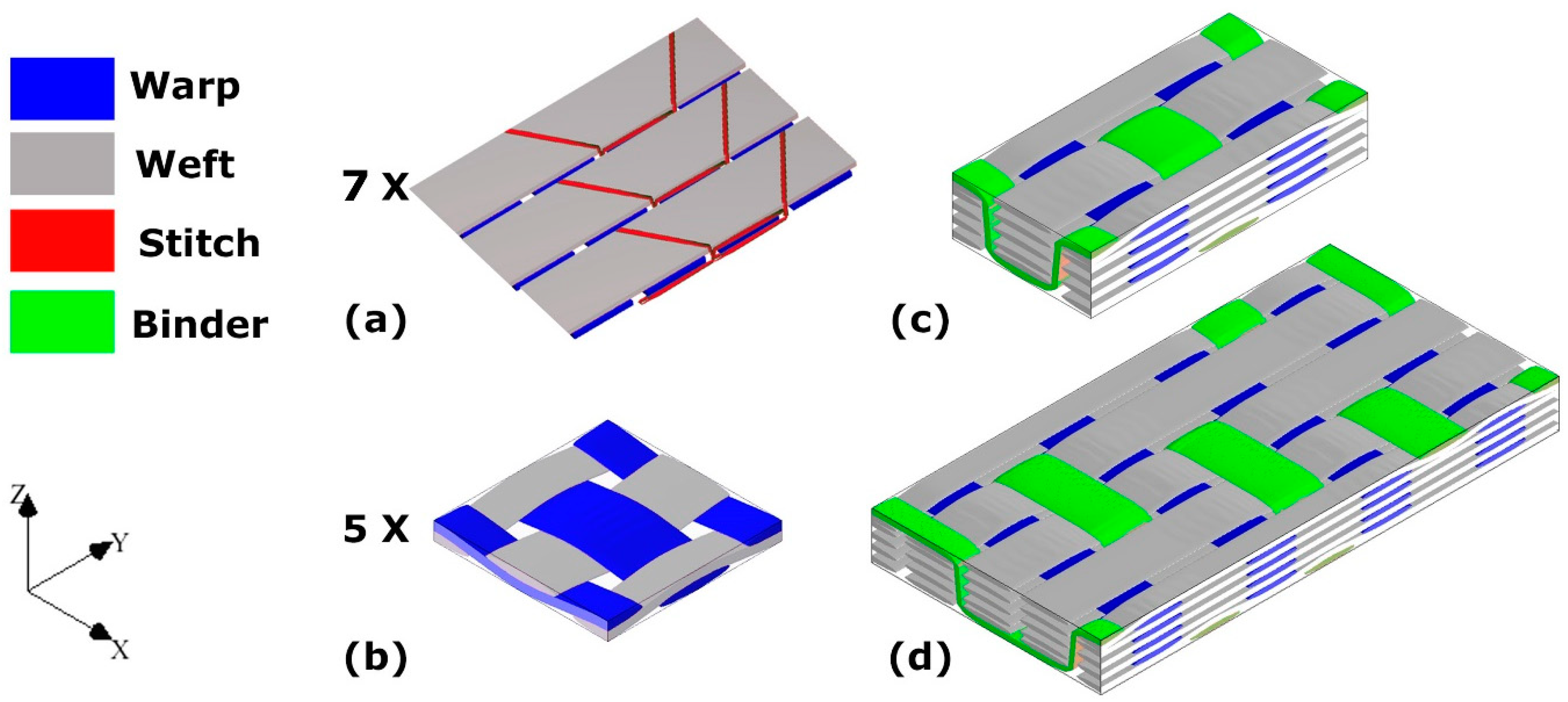

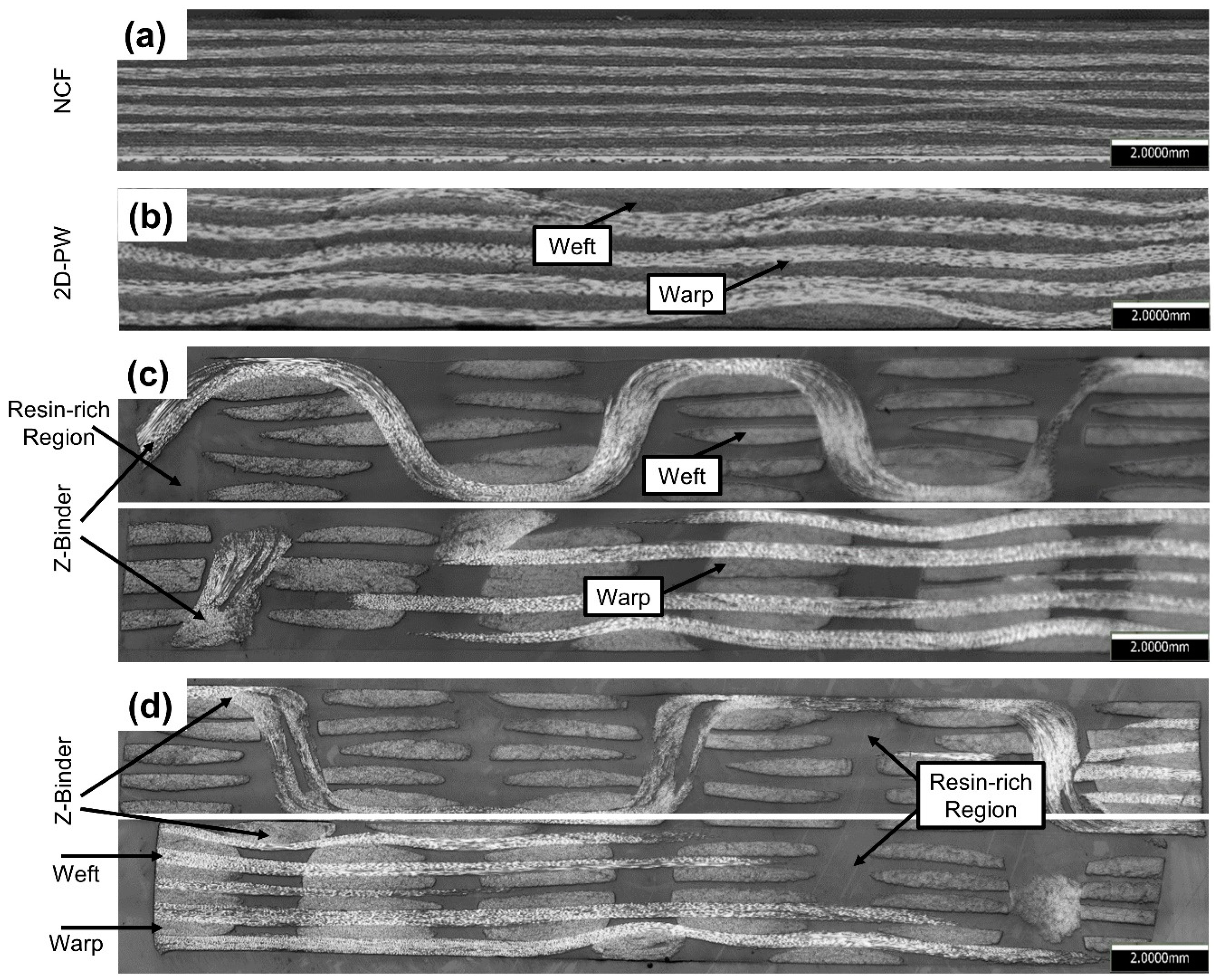

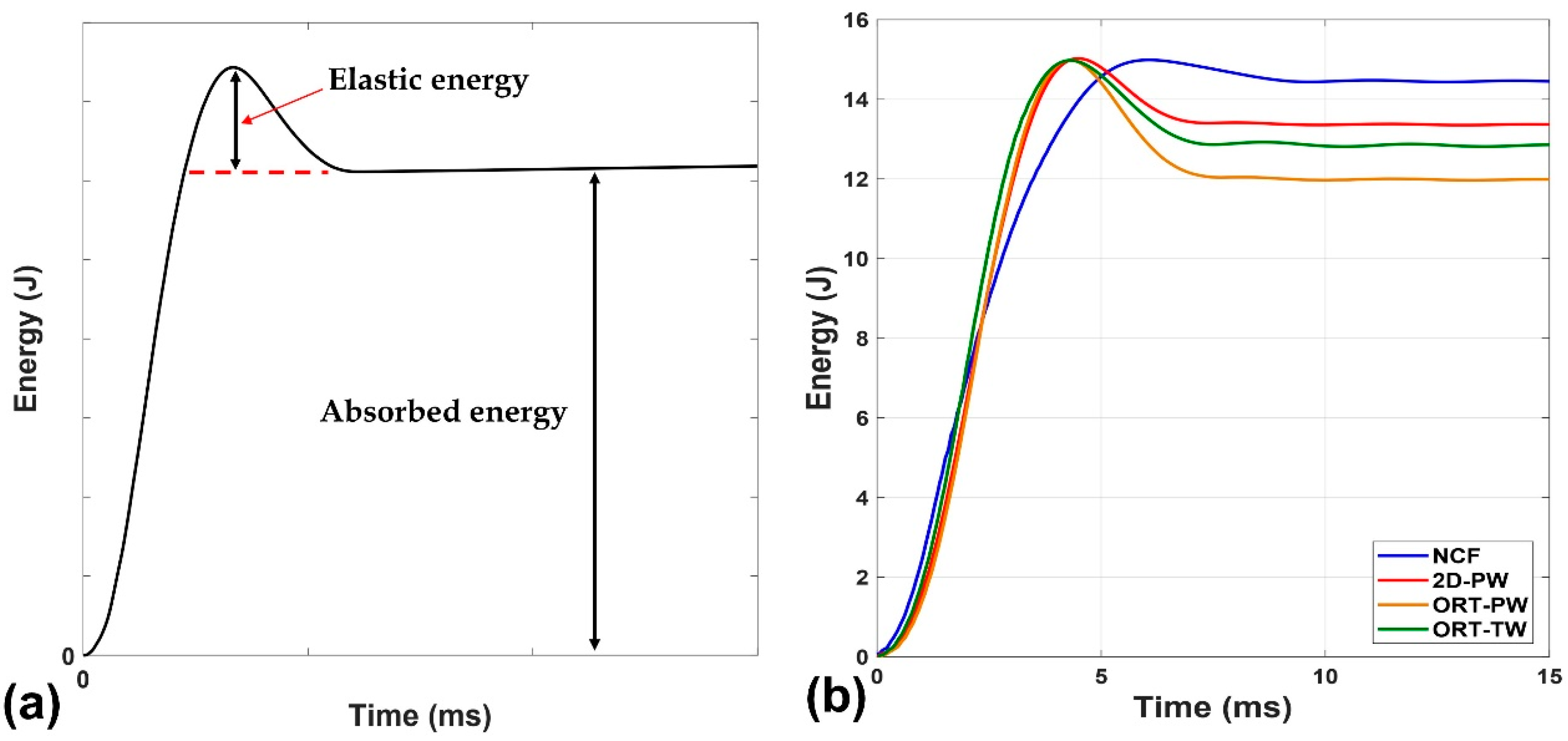


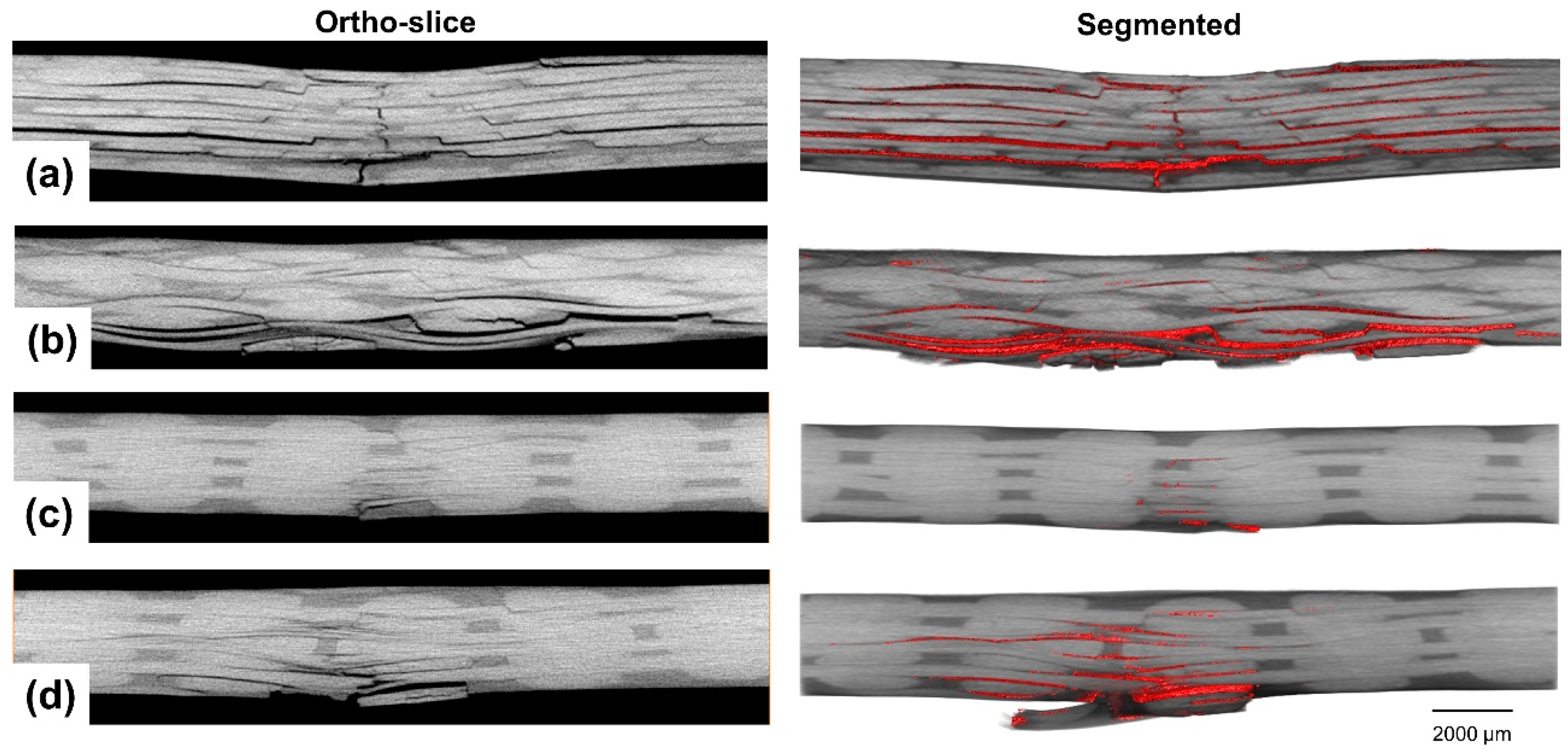

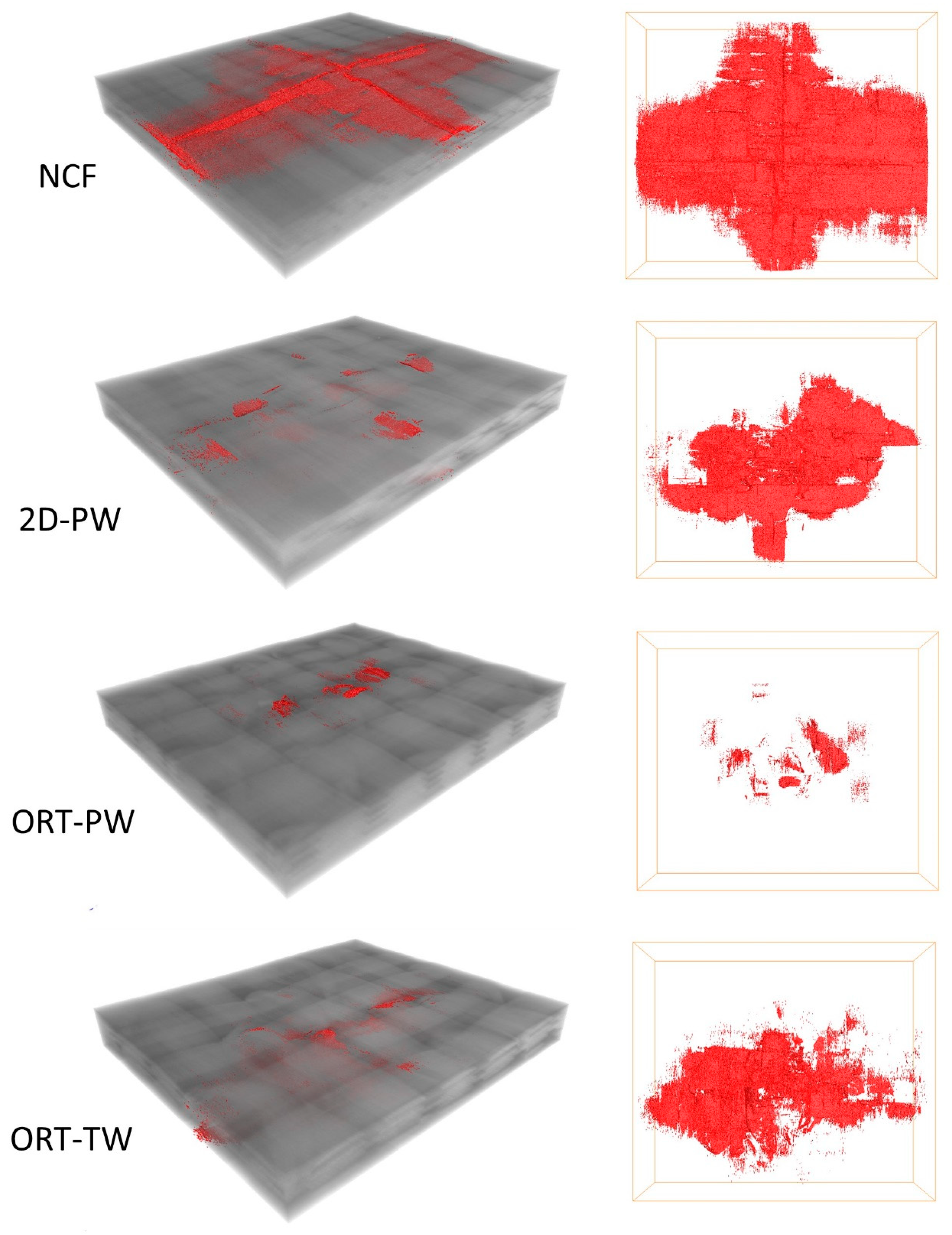
| C-Scan Area (%) | Absorbed Energy (J) | DD Parameter (J/J) | EDA/A (J/cm2) | |
|---|---|---|---|---|
| NCF | 1.81 ± 0.29 | 14.38 ± 0.31 | 0.96 ± 0.02 | 5.30 ± 0.11 |
| 2D-PW | 1.05 ± 0.12 | 13.34 ± 0.12 | 0.89 ± 0.01 | 8.47 ± 0.08 |
| ORT-PW | 0.66 ± 0.08 | 12.23 ± 0.59 | 0.82 ± 0.04 | 12.35 ± 0.60 |
| ORT-TW | 1.02 ± 0.03 | 12.81 ± 0.93 | 0.85 ± 0.06 | 8.37 ± 0.61 |
| Volume of Segmented Damage (mm3) | Composite Panel Thickness (mm) | Scanned Area Width × Height (mm × mm) | Damage Volume Fraction (%) | |
|---|---|---|---|---|
| NCF | 42.02 | 2.63 | 18.97 × 22.16 | 3.80 |
| 2D-PW | 17.78 | 2.48 | 18.97 × 22.16 | 1.71 |
| ORT-PW | 0.62 | 2.48 | 18.97 × 22.16 | 0.06 |
| ORT-TW | 13.97 | 2.64 | 18.97 × 22.16 | 1.26 |
Publisher’s Note: MDPI stays neutral with regard to jurisdictional claims in published maps and institutional affiliations. |
© 2021 by the authors. Licensee MDPI, Basel, Switzerland. This article is an open access article distributed under the terms and conditions of the Creative Commons Attribution (CC BY) license (http://creativecommons.org/licenses/by/4.0/).
Share and Cite
El-Dessouky, H.M.; Saleh, M.N.; Wang, Y.; Alotaibi, M.S. Effect of Unit-Cell Size on the Barely Visible Impact Damage in Woven Composites. Appl. Sci. 2021, 11, 2364. https://doi.org/10.3390/app11052364
El-Dessouky HM, Saleh MN, Wang Y, Alotaibi MS. Effect of Unit-Cell Size on the Barely Visible Impact Damage in Woven Composites. Applied Sciences. 2021; 11(5):2364. https://doi.org/10.3390/app11052364
Chicago/Turabian StyleEl-Dessouky, Hassan M., Mohamed Nasr Saleh, Ying Wang, and Mohamed S. Alotaibi. 2021. "Effect of Unit-Cell Size on the Barely Visible Impact Damage in Woven Composites" Applied Sciences 11, no. 5: 2364. https://doi.org/10.3390/app11052364
APA StyleEl-Dessouky, H. M., Saleh, M. N., Wang, Y., & Alotaibi, M. S. (2021). Effect of Unit-Cell Size on the Barely Visible Impact Damage in Woven Composites. Applied Sciences, 11(5), 2364. https://doi.org/10.3390/app11052364







